Ingredients for Cartersville’s Electric Age
By: Joe F. Head
As early as May 3, 1900 Cartersville entrepreneurs had launched their first Canning Factory to benefit its citizens. Additionally, an icehouse, freezer locker, two canning factories and local cooking schools were all made possible by electricity. As years followed the community saw the presence of Georgia Power offering a home economist division encouraging the use of modern kitchen appliances.
By 1906 the City of Cartersville had successfully installed city water, gas and electricity. Indoor plumbing had yet to be achieved, but modern conveniences were on the rise and were focusing on food preparation. The target market included wives and women of the community who might be persuaded to purchase services or kitchen appliances to replace traditional wood burning stoves and ice boxes.
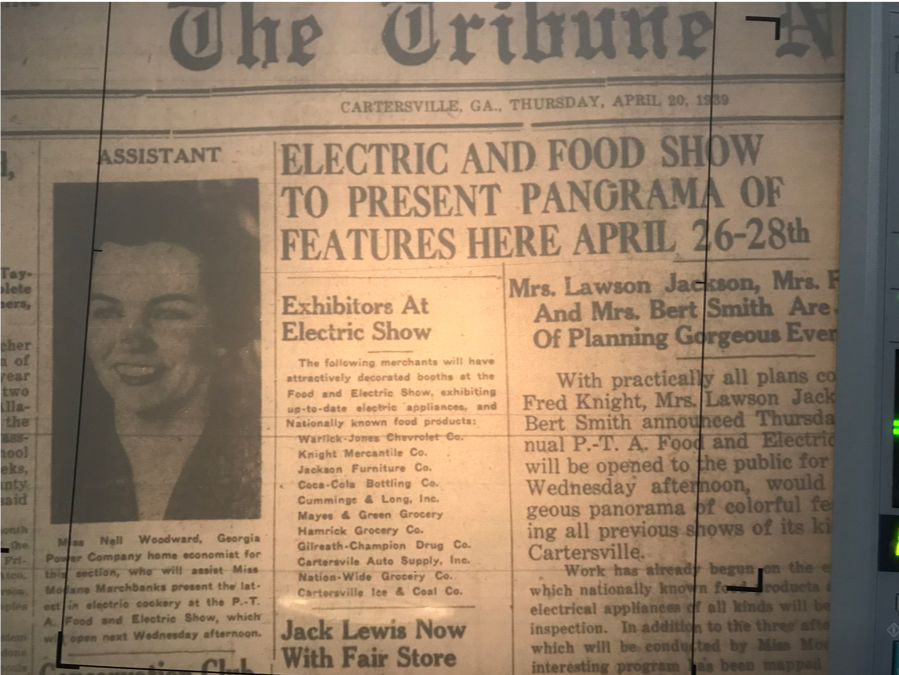
Driving this phenomena was the rise of the Georgia Power Company and its ambition to sell greater quantities of electricity. Georgia Power evolved from the Georgia Railway and Electric Company. To achieve this goal Georgia Power strategically began to promote its electrical service to residential and commercial markets using a number of methods. One in particular was the introduction of community Cooking Schools that often partnered with local businesses wishing to exhibit and sell modern electrical appliances. By 1926, Georgia Power established contracts with Women’s Clubs, high schools and the State College of Agriculture in Athens. They expanded their home economist department to offer a core of “home service girls” or representatives who were trained to help with cooking instruction. The featured speakers were Mrs. Carol Crawford, director; Mrs. Ada Crawford economist and Mrs. Katherine Babb, economist. As a by-product the home economics division added cookbooks and a radio show as a service to further encourage the use of cooking with electric appliances.
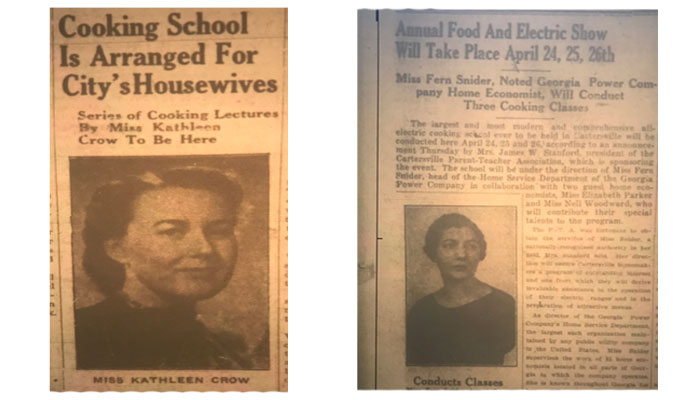
The earliest record of cooking schools first appeared in the newspaper on October 8, 1928. The ladies of the American Legion Auxiliary held a weeklong school consisting of lectures, demonstrations and classes for the community ladies.
The curriculum was a five-day course taught by Mrs. Elizabeth Stanfield offering instruction for breads and desserts on Monday, meats and vegetables on Tuesday, cakes and fillings on Wednesday, salads and molded salads on Thursday, concluding with croquettes on Friday. Season tickets were $1.00 or .25 cents per day for a single class. Tickets were available for purchase at Gilreath-Champion Drugs and Scheuer Brothers dry goods store.
The school was held at the American Legion with Jackson Furniture Company providing a functional demo kitchen. Cooking schools continued to be a popular activity with the American Legion ladies for several years.
By 1932 local churches began to conduct cooking schools with the first possibly being the Circle Two Women’s Auxiliary of the Presbyterian Church. Mrs. Alva Moore conducted the class.
Soon following in 1936, Georgia Power appeared on the scene with their well-known food economist Mrs. Ethel P. Lewis of Atlanta. According to the newspaper she held classes for three afternoons at the Cartersville High School Gymnasium (former Rev. Sam Jones Female College site) on the corner of Cherokee and Lee Streets. Ladies of the community decorated with colorful streamers that ran across the top of the gym.

The building was filled with exhibit booths and local merchants showcased their appliances. The event was billed as the “Cartersville Food and Electric Show” and was sponsored by the Tribune News, the Parent Teacher Association (PTA) and leading food and electric leaders. Reviews praised Mrs. Lewis for her charm and culinary skills stating that hundreds came each day to see the exhibits and demonstrations. According to the newspaper a special closing event was arranged to allow two men the opportunity to prepare a meal. Some 600 spectators were not initially impressed until the food was served and every one was delighted with the tasty outcome. The two men were Mr. George Nelson of the GE-Edison Company and Mr. H. A. Smeeton of Georgia Power. The two put on a humorous cooking skit and their identities were later introduced to a surprised audience.
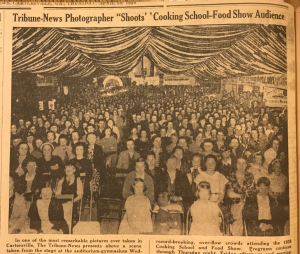
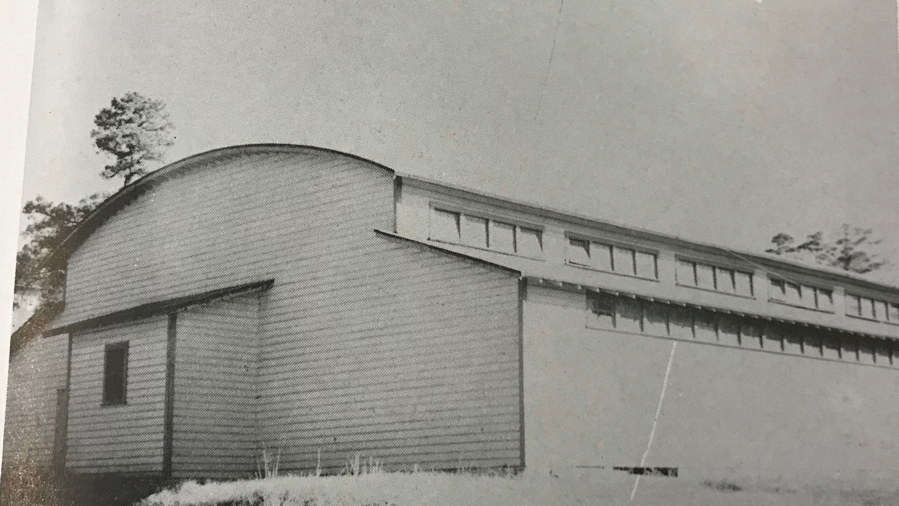
Georgia Power debuted its Electric and Food Show in 1936 offering a panorama of electrical features. Local merchants exhibiting included: Warlick Jones Chevrolet, Knight Mercantile, Jackson Furniture, Coca Cola, Cummings and Long Furniture, Mayes & Green Grocery, Hamrick Grocery, Gilreath-Champion Drug Store, Cartersville Auto Supply, Nation-Wide and Cartersville Ice and Coal Co.
Mrs. Lelia Pittman Johnson recalls her mother, Mrs. Emily Daves Pittman enrolling in one of the cooking schools held at the old Cartersville Gymnasium. Her family also had a compartment at the freezer locker. They lived a very frugal life style, put up canned goods and lived in a Sears kit house on north Erwin Street. She remembers that following the cooking class they did purchase a new stove from Jackson Furniture Company.
Georgia Power continued its state wide cooking school success returning to Cartersville with three more schools offered in April of 1940. The featured instructor was Miss Elizabeth Parker, home economist and regional celebrity of radio and magazine. Miss Fern Snider was also cited in subsequent announcements to teach sessions and had taught over 85 classes. The three cooking schools were a joint effort between Mrs. James A. Stanford, Cartersville PTA president and Georgia Power.
In 1942 the Cartersville City Schools’ PTA offered another slate of Cooking schools on April 22, 23, 24, apparently without the support of Georgia Power. Miss Kathleen Crow instructed and was a graduate of the famed Spry Kitchen of Cambridge, Massachusetts.
Following the success of earlier culinary classes, The Euzelian Women’s Class of the Tabernacle Baptist Church began offering cooking schools in 1940. They, too, promoted Mrs. Stanfield as the culinary expert and promised to feature state-of-the-art appliances, recipes for well balanced nutrition and instructions on how to use modern ranges. The class was held at the former Douglas Street School auditorium. Proceeds were to be used for the Tabernacle building fund. Tickets to the class cost fifty cents and that included a copy of Mrs. Stanfield’s cookbook publication. Twenty-five lucky participants received door prizes for attending.
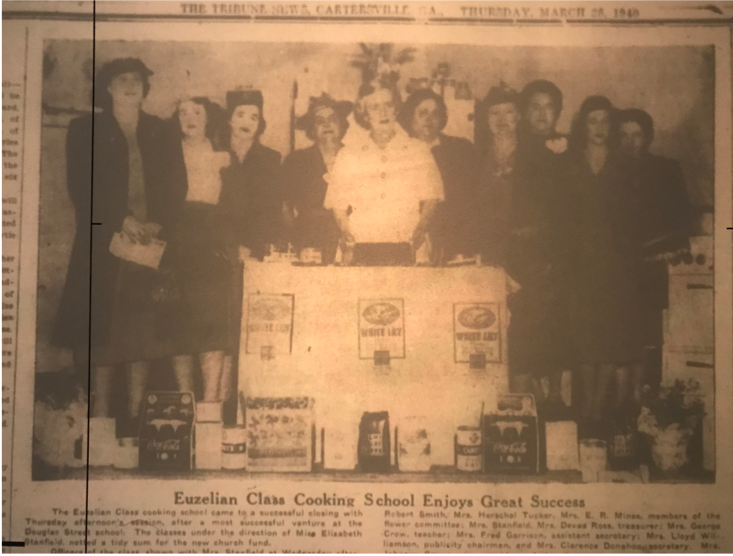
As the success of cooking classes rose, the public schools begin to include home economics in the high school curriculum. It was almost imperative that high girls take cooking classes and young men take industrial arts.
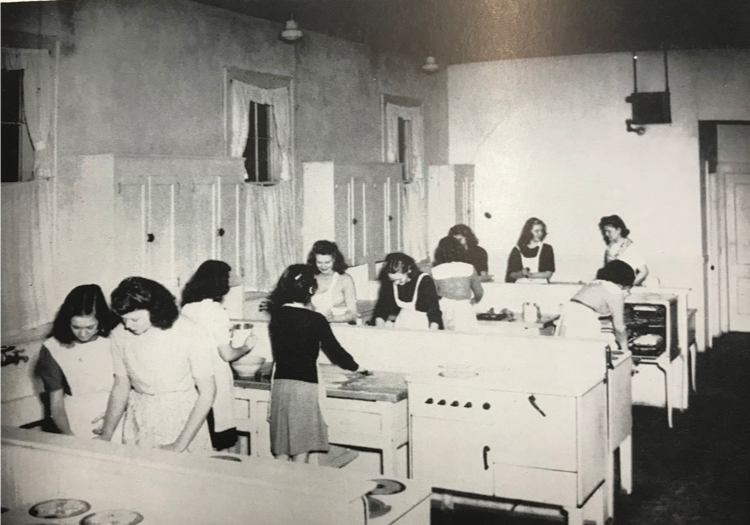
Canning Plants
An early newspaper mention of a canning plant opening appeared in May of 1900 in time for the fruit harvests later that summer. The plant was known as the Elberta Canning Company. It was lead by Mr. H. E. Cary, secretary and treasurer of the Cartersville Bank. The company touts a factory capacity of 3000 two-pound cans per day or 4000 three-pound cans per day.
Some 43 years later in 1946, a canning plant construction was announced at the municipal market. The canning plant committee consisted of City Manager Crane, Commissioner Arthur Neal and William Shadden. In July of 1943, the paper reported that M. W. H. (Alphabet) Collins, Farm Extension Agent announced that the Agricultural Extension Service would provide a trained lady to demonstrate proper canning procedures. The canning demonstrations were be sponsored by the Bartow County Cannery.
The City of Cartersville and Bartow County jointly owned the plant managed by Mr. E. W. Reeves. It employed five people to supervise customers who came to can food goods. It averaged 20 to 40 people per day and was open Monday through Friday from 8:00 to 5:00. The plant could produce an average of 1500 cans daily for six cents for a number 2 can or seven cents for a number 3 can. It was noted that some of the city’s most prominent citizens frequented the cannery.
For customer convenience, articles appeared in the newspapers when additional services, staff, equipment and telephones were added to the two canning plants.
As WWII emerged, canning plants in the 1940s were popular throughout the country. National promotions were featured in local papers of the wives of Washington, D.C. officials working to promote the Department of Agriculture Home Canning Week. Georgia Power returned to the scene with service plans to help customers conserve for war victory by assisting in the repair of appliances to curb the need for replacing products. The plan also was directed to optimize food production and conservation.
Freezer Locker
By 1945 Cartersville opened its first freezer locker located on south Tennessee Street. The Tribune News reported on January 25, 1945 that Mr. R. D. Hale owner and operator announced the plant was ready for business with a capacity of 500 lockers renting for 12 to 15 dollars each. The locker also offered processing and butcher services. Upon opening they were expecting several thousand pounds of meat for curing and freezing.
Mrs. Betty Warlick Archer recollects the freezer lockers, cannery and old wooden icehouse. She recalls visiting with her mother the freezer locker located on south Tennessee Street diagonally across the street from today’s Tribune News. She vividly remembers having to put on a heavy coat provided by the freezer locker and walking into the large room-like cooler. There she saw small compartments where families would rent cooler space for storing meats, produce and fruits.
She also recalls seeing the city – county owned cannery located on Erwin Street that was north of the old Tinsley Park. As she remembers it was a long wooden, one floor building. Her mother canned there and packed her food stuffs in metal cans that were sealed on site.
Mrs. Ann Miller Wheeler grew up in Cartersville and remembers the freezer lockers located on Tennessee Street and the icehouse. Her father was a butcher and she recalls that people would have him prepare wild game and sides of beef to be stored in the lockers. She remembers the compartments were about the size of a large safety deposit box and everyone had a key to secure their meat.
Icehouse
Cartersville also had an icehouse facility located on Leake Street on the east side of the railroad crossing. Here the Southland Ice Company produced 12×12 inch blocks of ice. Locals would visit the icehouse on weekends and purchase a brown double bagged sack of chipped ice. The ice chipper was loud and water was constantly running out the door and through the platform planks. Mrs. Archer also remembers watermelons and Coca-Colas submerged in ice that could be purchase there. She also recalls Cartersville had a block ice delivery service and milk delivered to homes in glass bottles by Jackson’s Dairy.
A recipe for Success!
The emergence of the electrical age gave rise to modern home cooking conveniences with the introduction of refrigerators, stoves, toasters and ceiling lights. Additionally, Cartersville residents and commercial enterprises offered a fresh market for Georgia Power. Incentive to collaborate with appliance stores in order to host and exhibit demonstrations designed to motivate the sale of more home appliances or purchase commercial, electrical, services was a savvy Georgia Power strategy. As a result, cooking schools, canneries and freezer lockers were a natural recipe to generate interest and stir early community action.
Ironically, 21st century women watch Paula Deen, Pioneer Woman, Giada, Emeril Lagasse and other nationally known chefs in the comfort of their homes using 50-inch wide TV screens, Ipads and You Tube. All of these devices are powered by electricity that has yet added another appliance to the menu. The power companies were surely onto something that remains a stove-top winner.
Bibliography
Newspapers/Articles
Note: Some article titles have been abbreviated
Tribune News, May 3, 1900, Will Build Canning Factory
Tribune News, March 13 1900, Plans Completed for Cooking School
Tribune News, October 8, 1928, Cooking School Program Begins
Tribune News, November 1, 1928, Cooking School Closed Great Success
Tribune News, February 13, 1930, Legion Auxiliary Sponsors Cooking School
Tribune News, February 18 and March 3, 1932, Cooking School Great Success
Tribune News, April 13, 1933, Three Day Cooking School Opens Here Next Tuesday
Tribune News, May 9, 1936, Ready for Cooking School
Tribune News, May 16, 1936, Electrical Supplies Displayed at Cooking School
Tribune News, April 23, 27 1936, Cooking School Brilliant Affair
Tribune News, April 14, 1938, Cooking School -Food Show Audience
Tribune News, March 16, 1939, Will Again Conduct Cooking School
Tribune News, April 20 and 27, 1939, Electric and Food Show Panorama
Tribune News, April 4, 1940, Conducts Tree Cooking Schools
Tribune News, February 29, 1940, Cooking School at Tabernacle
Tribune News, March 7, 1940, Cooking School to Aid Church Building Fund
Tribune News, March 21, 1940, Euzelian Class Cooking School to Open Tuesday
Tribune News, April 23, 1940, Day Session of PTA Cooking School
Tribune News, April 25, 1940, Cartersville House Keepers Enjoy Cooking School
Tribune News, April 2, 1942, Cooking School is Arranged For City’s Housewives
Tribune News, February 12, 1942, Cooking School to be held at Market Street Gym
Tribune News, June 24, 1943, Canning Plant Ready for Work
Tribune News, July 1, 1943, Demonstrations in Canning Methods
Tribune News, July 7, 1943, Canning Plant Is Ready for Service
Tribune News, September 14, 1944, Canning Plant Open 3 Days Week
Tribune News, June 28, 1945, Canning Plant Now Open each week
Tribune News, January 25, 1945, Freezer Locker Plant Gets Ready to Receive Meat
Tribune News, July 5, 1945, Stegall Operated Canning Plant
Tribune News, May 25, 1944, Immediate Erection of Modern Freezer Locker
Tribune News, July 25, 1946, Cartersville Canning Plant in Operation
Newsletters, Books
EVHS Newsletter, June 2018, Vol 102, Jo Anne Branton, What’s Cooking?
Cartersville High School Yearbooks, CAHISCO, 1949 – 52
History of the Georgia Power Company, 1855 1956, Wright, H. Wade
Georgia Historical Society Footnotes, Summer 1996
Home Service Department Changes Name, Robbie Ladd, Georgia Power, 11/1978
Sales Department Yearbook, 1928 Home Services Division, Georgia Power
Round the Home, Volume XII, February 1942, Georgia Power
Interviews
Mrs. Lelia Pittman Johnson, February 2019, Cartersville GA
Mrs. Betty Warlick Archer, March 15, 2019, Cartersville GA
Mrs. Ann Miller Wheeler, March 18, 2019, Cartersville GA
